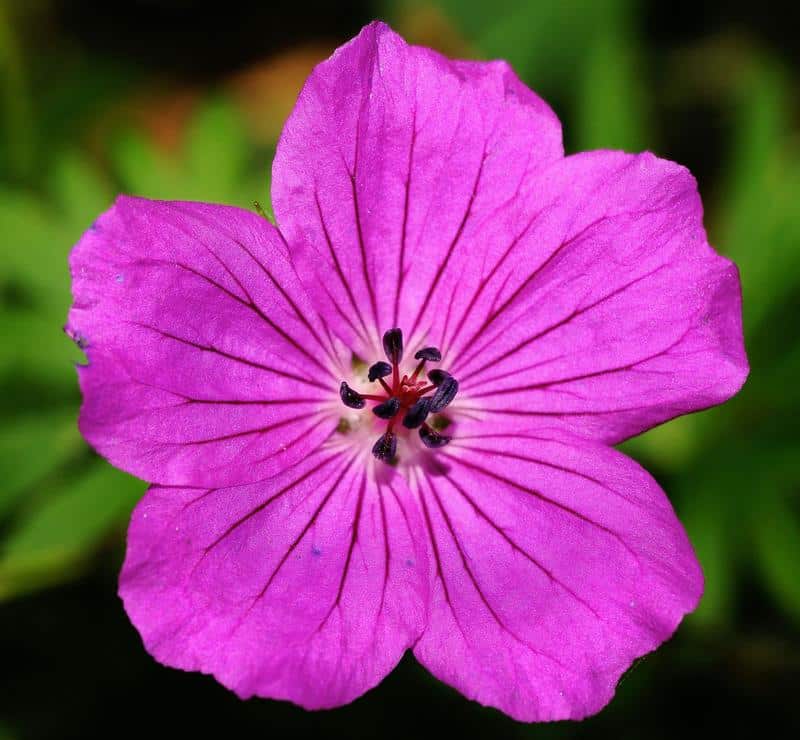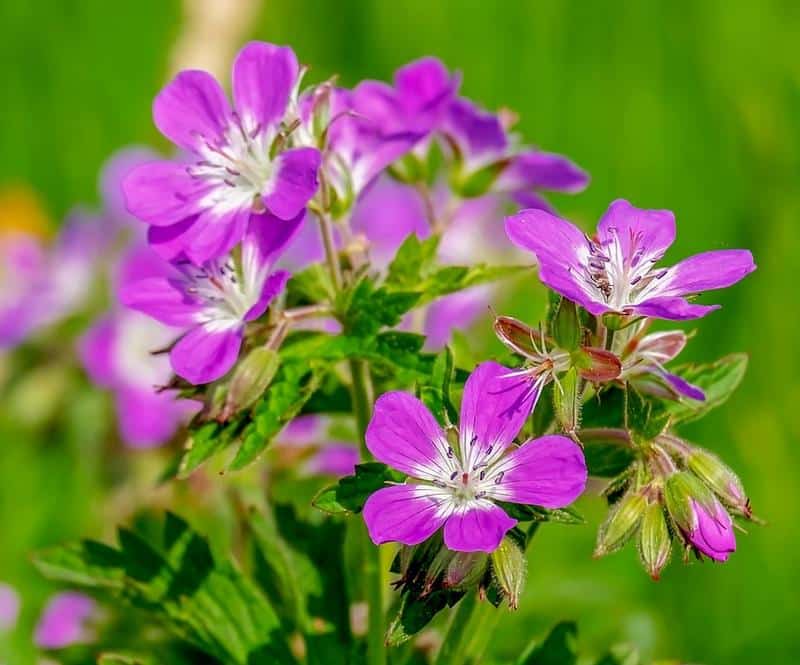Are Geraniums Toxic to Dogs? Are Geraniums Safe for Dogs?
Are geraniums toxic to dogs? Are geraniums safe for dogs? In this article, we’ll cover everything you need to know about if geraniums are poisonous to dogs (zonal, cranesbill, horseshoe, more), including what to do if they’ve already eaten geranium. We’ll then teach you the two commands that will ensure your dog is always safe around geraniums from now on.
Next, we’re going to fill out your knowledge on geraniums and dogs by telling you how to keep dogs away from geraniums (and other possibly toxic plants). Finally, we’ll wrap up by instructing you on how to grow, care for, and deadhead geraniums when you have dogs. Keep reading!
Are Geraniums Toxic to Dogs?

Geraniums are toxic to dogs. If eaten, they can cause unpleasant symptoms like vomiting, reduced appetite, depression, and skin irritation. It’s important to ensure your pets do not have access to these plants to prevent ingestion and the resulting negative effects.
Are Geraniums Safe for Dogs?
Geraniums are not safe for dogs. The American Society for the Prevention of Cruelty to Animals (ASPCA) lists geraniums as toxic to dogs. If ingested, geraniums can cause several clinical signs, including vomiting, depression, dermatitis, and reduced appetite.
If your dog has eaten any part of a geranium plant and is exhibiting these signs, contact your veterinarian immediately.
Train the “Leave It” Command
The “Leave It” command is an essential tool in keeping your dog away from geraniums and other potentially harmful substances. Here’s how to train your dog to respond to it:
- Hold a treat in a closed fist.
- Say “leave it.”
- Wait until your dog stops trying to get the treat and then reward them with a different treat from your other hand.
Regularly practicing this command will help discourage your dog from approaching and trying to eat geraniums or any other unsafe items.
Train the “Drop It” Command
The “Drop It” command is another essential safety command that can come in handy if your dog picks up a piece of a geranium or any other harmful item. Here’s how to train this command:
- Begin a game of tug with a toy.
- While playing, say “drop it” and stop tugging.
- When your dog releases the toy, reward them with a treat.
This command can prompt your dog to drop the geranium or any toxic item they may have picked up, potentially preventing the ingestion of harmful substances.
While geraniums may be attractive and popular plants, they pose a risk to dogs if eaten. These commands will help stop that, but it’s important to remember that the underlying behavioral issues (curiosity, anxiety, boredom, etc.) that were causing all of this to begin with will still be present.
And until you address those, any positive changes you see are only going to be temporary.
“Well, how do I make these changes last?”
By getting your dog to truly choose to follow your direction, that’s how. I tried many times to write out how you can do that before deciding it made more sense to just link you to the free video series that explains it better than I’d ever be able to.
The series is by a man named Dan who is one of the world’s leading dog obedience trainers. In it, he teaches you how to put an end to things like your dog eating geraniums and all other misbehavior using his fast and easy-to-follow methods.
In the first video, Dan will reveal to you why the two most common methods of dog training only doom you to failure. You can watch the video now by clicking here. Follow the proven system he’ll show you in his series and you’ll never have to spend another second worrying about your dog eating a geranium ever again!
Are Geraniums Poisonous to Dogs?

Geraniums are poisonous to dogs. This flowering plant contains toxins that can cause a variety of symptoms in dogs, such as vomiting, depression, and dermatitis. It’s important to keep geraniums out of your dog’s reach to prevent accidental ingestion.
Are Geranium Leaves Poisonous to Dogs?
Geranium leaves are poisonous to dogs, as are all parts of the geranium plant. If consumed, they can lead to unpleasant symptoms such as vomiting, loss of appetite, depression, and skin irritation.
Are Zonal Geraniums Poisonous to Dogs?
Zonal geraniums are poisonous to dogs. Like other geranium varieties, they can cause gastrointestinal upset and skin irritation if consumed. Zonals are popular for their beautiful and distinct zones of color in their leaves,
Are Cranesbill Geraniums Poisonous to Dogs?
Cranesbill geraniums are poisonous to dogs. Their ingestion can result in similar symptoms of discomfort, including vomiting and skin irritation.
Are Horseshoe Geraniums Poisonous to Dogs?
Horseshoe geraniums are poisonous to dogs. Your dog eating them could lead to various symptoms such as vomiting, depression, and dermatitis in dogs. Horseshoe geraniums are recognized by their rounded leaves with darker circular markings.
Are Hardy Geraniums Poisonous to Dogs?
Hardy geraniums are poisonous to dogs. If your pet consumes this plant, they may experience discomforting symptoms like vomiting, skin irritation, and depression. They are often confused with Cranesbill geraniums.
In conclusion, while geraniums are attractive and a common sight in many gardens, they are toxic to dogs and can lead to uncomfortable and potentially serious symptoms if ingested. Always ensure that your pets are unable to access these plants and consider alternative, pet-safe plants for your garden.
If your dog has ingested any part of a geranium plant, please contact your vet immediately for advice. Learn the two commands that will prevent future problems by going back to the first section.
What to Do if Dog Eats Geranium

If your dog eats a geranium, it’s important to contact your veterinarian or an emergency animal poison control center right away. Geraniums are toxic to dogs and can lead to symptoms like vomiting, depression, and skin irritation. While not typically lethal, prompt veterinary attention can help alleviate symptoms and prevent complications.
My Dog Ate a Geranium, What Do I Do?
If your dog ate a geranium, don’t panic. Remain calm and remove your dog from the area to prevent further consumption. Try to determine how much of the plant your dog may have eaten, and look for any immediate symptoms such as vomiting or signs of discomfort.
Contact your vet or a pet poison helpline as soon as possible. They can provide guidance based on the amount ingested and your dog’s size, breed, and overall health.
Dog Eating Geraniums: How to Prevent It
Preventing your dog from eating geraniums begins with awareness and good pet management. Understand the risks of toxic plants, like geraniums, and make sure they’re out of your dog’s reach.
Training commands like “Leave It” and “Drop It” can also be incredibly useful to deter your dog from ingesting potentially harmful substances. Learn both in the first section now.
Regular supervision, particularly during walks or playtime in new environments, is also essential.
Choosing Dog-Safe Plants
If you’re a pet owner and a gardening enthusiast, it’s vital to choose dog-safe plants for your garden. Many beautiful, non-toxic plants are equally enjoyable and safer for pets. Some examples include sunflowers, roses, and certain types of ferns and herbs. Always research a plant’s safety for pets before introducing it to your home or garden.
In conclusion, it’s important to act right away if your dog eats geranium. Reach out to a veterinary professional for advice, monitor your dog for symptoms, and take measures to prevent future incidents.
Providing a safe environment, coupled with effective training commands and supervision, can help ensure your dog remains healthy and happy.
It’s a very good idea to handle this problem now, as doing that will also keep your dog safe around other plants which might be harmful. You then won’t have to worry about things like are SunPatiens poisonous to dogs, are New Guinea Impatiens poisonous to dogs, are Impatiens poisonous to dogs, or is alyssum toxic to dogs.
Geraniums and Dogs

Geraniums are toxic to dogs, leading to potential health issues if ingested. While geraniums are beautiful, they should be kept out of a dog’s reach to avoid any problems. Essential actions to prevent ingestion include dog training, creating a safe environment, and educating oneself about dog-safe plants.
How to Keep Dogs Away From Geraniums
Keeping dogs away from geraniums primarily involves creating physical barriers and supervising your pet’s outdoor time. You can set up fences or use elevated planters to restrict your dog’s access to these plants.
Furthermore, ensuring that your dog is always supervised when outside can prevent them from getting into trouble with geraniums or other potentially harmful plants.
Training Commands to Prevent Ingestion
Training your dog with commands like “Leave It” and “Drop It” can be instrumental in preventing them from consuming geraniums. The “Leave It” command can deter your dog from approaching or picking up the plant, while “Drop It” can make them release it if they have it in their mouth. Learn both now in the first section.
Consistent training and reinforcement are key to these commands’ effectiveness.
Creating a Safe Outdoor Environment
Creating a safe outdoor environment for your dog is paramount. Ensure the outdoor areas your dog has access to are free from geraniums and other toxic plants. If you’re unsure about a plant’s toxicity, it’s best to err on the side of caution and keep it out of your dog’s reach.
Dog-Safe Alternatives to Geraniums
If you love gardening but want to ensure your plants are safe for your dog, consider dog-safe alternatives. Plants such as roses, sunflowers, and certain ferns and herbs are both beautiful and safe for dogs.
In conclusion, while geraniums can be harmful to dogs if ingested, there are various ways to ensure your dog’s safety around these plants. Training your dog, creating a safe environment, and choosing dog-safe plants can all contribute to keeping your furry friend healthy and happy.
How to Grow, Care For, and Deadhead Geraniums

Growing, caring for, and deadheading geraniums involves several steps: sowing or planting in a sunny, well-drained location, watering regularly but not excessively, fertilizing during the growing season, and deadheading spent blooms to encourage further flowering.
Geraniums are popular garden plants due to their vibrant colors and relative ease of care, making them a great choice for both beginner and experienced gardeners.
- Planting: Geraniums can be grown from seed, cuttings, or young plants. They prefer a sunny location with well-draining soil. If you’re planting in pots, make sure there are adequate drainage holes. For garden planting, enrich the soil with organic matter like compost to enhance drainage and provide necessary nutrients.
- Watering: While geraniums are somewhat drought-tolerant, regular watering helps them flourish. However, avoid overwatering as this can lead to root rot. Water deeply but infrequently, allowing the soil to dry out between watering sessions. Plants in containers may require more frequent watering than those in the ground.
- Fertilizing: To support robust growth and vibrant blooming, fertilize geraniums every 4-6 weeks during the growing season with a balanced plant food. It’s best to follow the specific instructions provided on your chosen fertilizer, as over-fertilization can lead to more leaves but fewer flowers.
- Deadheading: Regularly removing, or ‘deadheading‘, spent geranium flowers promotes more blooms and extends the flowering period. Simply snip off the faded flower heads at their stems to redirect the plant’s energy toward new growth. This will help your geraniums look tidier and encourage more vibrant blooms.
With their vibrant blooms and relative hardiness, geraniums are a valuable addition to any garden. By providing them with suitable growing conditions and proper care, you can enjoy their vivid colors throughout the growing season. Learn to keep your dog away from them by going back to the first section.
I’m sure you’re ready to have all of this behind you so that your geraniums and dogs can thrive together, so I’ll let you get started now. Good luck, and thanks for reading our article “Are Geraniums Toxic to Dogs? Are Geraniums Safe for Dogs?”





